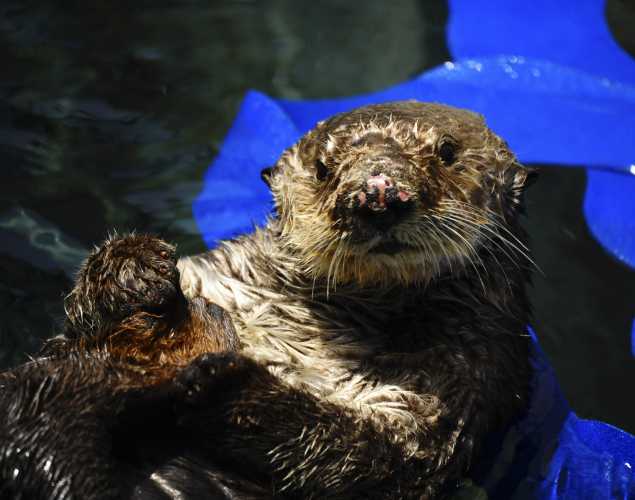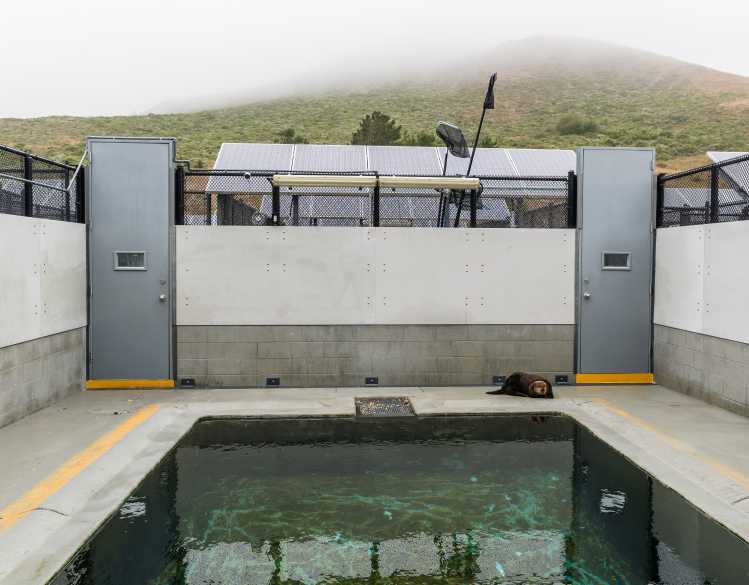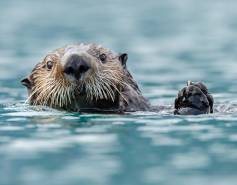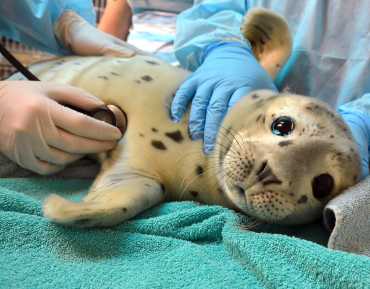
Otter Conservation Efforts Bolstered By New Rehabilitation Space
- Domoic acid
- Species conservation
As part of the Center’s efforts to advance global ocean conservation and the recovery of threatened species, our newly retrofitted pens provide a safe space for rehabilitating southern sea otters.
For months at a time during our busy pupping season, our Fish Kitchen freezer is full of hundreds of pounds of frozen herring stacked in boxes and sorted into buckets. But in recent months, we’ve cleared a shelf for seafood delicacies such as scallops, clams, squid and shrimp. Who’s the picky patient with a sophisticated palette?
Meet Otto
He’s an eight-year-old southern sea otter named Otto, who was rescued in Morro Bay by our response team based at our San Luis Obispo facility. Although he was very lethargic when he was first rescued, Otto has since built up quite an appetite for his daily meals of restaurant-grade seafood offerings.
During his admit exam, our veterinarians noted that Otto was underweight for his age and had some scrapes on his nose, likely due to fighting with other males in the wild, but otherwise seemed to be in fairly good health. They took radiographs and blood, urine and fecal samples to examine in the lab to determine if Otto had any underlying health concerns that might have caused his stranding.
Over the last three months, Otto has been improving daily and has gained nearly 15 pounds, or about a third of his body weight at admit. When he’s not eating, he spends much of his time swimming around the pool or floating on his back and grooming, which is vital for an animal with the thickest fur of any mammal—up to one million hairs per square inch.
But it’s not just sea otters’ thick fur and food preferences that make them special. Studies show that sea otters are a keystone species that helps shape and maintain healthy kelp forest and tidal wetland ecosystems. Sometimes called “ecosystem engineers,” these top predators help contain populations of sea urchins and crabs, allowing kelps and sea grasses to thrive and provide habitat to many other species.
A Threatened Species
Sea otters once served this important role as kelp and eelgrass “gardeners” along the entire Pacific Rim from Japan to Baja California, with a population estimated to be between 150,000 and 300,000 animals. But fur traders seeking their lush pelts hunted them to near extinction in the 18th and 19th centuries.
Now there are three distinct populations of sea otters: Asian sea otters live along Russia’s eastern coast, northern sea otters range from Alaska to Washington state, and southern sea otters live only along California’s central coast. Today’s California sea otters are descended from a small colony along the isolated Big Sur coast that survived the fur trade.
As many as 20,000 southern sea otters may have lived along the coasts of California and Baja California at one time, but that is no longer the case. For the last 40 years, southern sea otters have been listed as “threatened” under the federal Endangered Species Act with the population estimated at just a few thousand.
No single threat is solely responsible for the sea otter’s slow recovery from near-extinction during the fur trade. Southern sea otters die from a range of infectious diseases and human-caused pollutants, and bites from white sharks seem to be limiting the recolonization of sea otters into historical habitat along the northern and southern coast of California.
But thanks to dedicated recovery efforts, sea otters seem to be making a comeback in recent years. In 2016, the three-year average of the population reached 3,272 animals—a critical benchmarking step toward the long-term goal of population recovery and the removal of their threatened status.
“The Marine Mammal Center is proud to play an important role in these recovery efforts as a first responder for live strandings of sick, injured or orphaned sea otters along California’s central coast,” says Dr. Shawn Johnson, Director of Veterinary Science at The Marine Mammal Center. “We work closely with our partners at the U.S. Fish and Wildlife Service and Monterey Bay Aquarium to make decisions together about how to provide humane care for these rescued otters.”
Retrofitting for Rehabilitation
Although we were caring for more than 150 seals and sea lions at our peak this year, rehabilitating sea otters is a completely different ballgame—in part because they are an entirely different type of animal. Unlike our pinniped patients, sea otters are members of the Mustelid family, which includes weasels, badgers and wolverines.
The distinction is apt, because sea otters can be quite weaselly—they are known to be talented escape artists, using their dextrous paws to reach through fencing to grab items or unlock gates. Our larger sea lions are able to jump onto a ledge to get a better view out of the pen, but a sea otter can climb all the way up the fence and back down the other side.
That’s why we recently retrofitted two of our pen areas to be suitable for sea otters by replacing the fencing with solid walls of fiberglass-reinforced plastic. We also secured all of the grates and installed solid doors that lock from the outside with a key rather than a latch.
These two pool areas are tucked away from public view in order to reduce human noise and interaction, as sea otters can become quickly habituated to humans, sometimes leading to dangerous interactions for both humans and otters when they return to the wild. Closed circuit cameras in the pens allow animal care teams to monitor the sea otter without entering the pen, reducing our human contact time to feedings and weekly exams.
“Retrofitting part of our hospital in Sausalito to safely house sea otters means we’ve effectively increased rehabilitation capacity for this threatened species,” Johnson says. “We are now able to bring in animals like Otto in hopes of releasing them back to the wild to help contribute to the future health of the population and surrounding ecosystems.”

Finding Hope
Otto isn’t the first otter we’ve rehabilitated—over the years we’ve provided care for a number of otters, most notably Repo and Calloway. Otto’s not even the first we’ve treated since our recent retrofit construction.
For about a week in April, our experts cared for Hope, a young female otter that appeared to be a bit small for her estimated age of about seven to eight months when she was found stranded at Piedras Blancas near San Simeon in San Luis Obispo. Shortly after her arrival at our hospital, she lost her appetite, became less active and spent more time lying on the grate of her pool than in the water grooming or eating.
A thorough exam revealed some troubling but inconclusive results, and just two days later she died. A necropsy, or post-mortem exam, found that she was suffering from Valley Fever, a disease caused by a fungus that destroys the architecture of internal organs.
“Unfortunately, in Hope’s case, the Valley Fever was far too advanced to treat even if it had been diagnosed before she died,” says Pádraig Duignan, the Center’s Chief Research Pathologist. “Though we had hoped to release Hope back to the wild, her death still advances our recovery efforts for this species by teaching us so much about the disease agents that can impact the health of these animals.”
Sea Otter Research at The Marine Mammal Center
{"image":"\/Animals\/Wild\/Sea otter\/cropped-images\/sea-otter-face-shutterstock-423-0-3176-2481-1602701548.jpg","alt":"southern sea otter","title":"Clinical Signs and Pathology Associated With Domoic Acid Toxicosis in Southern Sea Otters","link_url":"https:\/\/www.marinemammalcenter.org\/publications\/clinical-signs-and-pathology-associated-with-domoic-acid-toxicosis-in-southern-sea-otters","label":"Research Paper","type":"publication"}

Clinical Signs and Pathology Associated With Domoic Acid Toxicosis in Southern Sea Otters
Read More{"image":"\/Animals\/Wild\/Sea otter\/cropped-images\/sea-otter-grooming-head-shutterstock-22-86-3617-2826-1616709449.jpg","alt":"sea otter grooming","title":"Parasitic Skin Disease in Threatened Southern Sea Otters","link_url":"https:\/\/www.marinemammalcenter.org\/publications\/parasitic-skin-disease-in-threatened-southern-sea-otters","label":"Research Paper","type":"publication"}

{"image":"\/Animals\/Wild\/Sea otter\/sea-otter-shutterstock.jpg","alt":"sea otter eating shellfish","title":"Parasite-Associated Hepatitis in Southern Sea Otters","link_url":"https:\/\/www.marinemammalcenter.org\/publications\/parasite-associated-hepatitis-in-southern-sea-otters","label":"Research Paper","type":"publication"}

{"image":"\/Animals\/Wild\/Sea otter\/sea-otter-photo-c-brian-simuro.jpeg","alt":"sea otter in a seagrass bed","title":"New Brucella Bacterial Infection in Southern Sea Otters","link_url":"https:\/\/www.marinemammalcenter.org\/publications\/new-brucella-bacterial-infection-in-southern-sea-otters","label":"Research Paper","type":"publication"}

A Diagnosis for Otto
In Otto’s case, the samples we took during his admit exam provided a clear diagnosis early in his treatment: domoic acid toxicosis, a condition caused by the neurotoxin domoic acid. Produced by a type of algae called Pseudo-nitzschia australis, this toxin accumulates in fish, and in shellfish like crabs, clams and scallops, which are then eaten by sea otters in large quantities.
Domoic acid toxicity primarily attacks the brain, causing lethargy, disorientation, seizures and if not treated, eventually, death. An MRI of Otto’s brain performed by our pro bono partners at AnimalScan in Redwood City, California, revealed that he had a shrunken hippocampus, the area of the brain known to play a role in memory and navigation, which is common in animals with domoic acid toxicosis.
Yankee Doodle, another adult male sea otter, was rescued about a month after Otto showing signs of neurologic disease. Thanks to AnimalScan, we were able to do an MRI on Yankee Doodle as well that revealed that he too had likely been exposed to domoic acid.
Unfortunately, this diagnosis is one we know all too well here at the Center. In fact, researchers here were the first to discover the condition in California sea lions back in 1998. And we’ve had plenty of opportunities to learn more since then—over the last few years, record-breaking blooms of the toxic algae have sickened hundreds of sea lions, and have even led to fishery closures to protect human health.
Although most of the patients we treat for domoic acid toxicity are California sea lions, other marine mammals are susceptible to its effects as well. Domoic acid has been reported in a number of other seal and sea lion species, as well as cetaceans such as blue and humpback whales. Just a few years ago, researchers at the Center were the first to detect domoic acid in Guadalupe fur seals, a threatened species just like the sea otter.
Domoic acid will naturally flush from an animal’s system over time once they are eating seafood that is free of domoic acid. But animals exposed to the toxin over a long period of time or through repeated contact can suffer longer-lasting and more serious effects.
In sea lions, we know what this looks like, and our experts can assess whether an animal has permanent brain damage by monitoring for healthy neurological behaviors such as alertness, the ability to move quickly on all four flippers and a natural instinct to avoid or be aggressive toward humans.
But in sea otters, these behaviors could look quite different and no neurological assessment has been developed thus far. In fact, very little is known about how domoic acid affects individual otters or the population as a whole.
The Center’s veterinary team is working closely with other sea otter experts to determine the best next steps to ensure that Otto and Yankee Doodle will be healthy enough for release back to the wild. In the meantime, they still need to gain quite a bit of weight, so our animal care volunteer crews are focused on keeping them fed, which means many more buckets full of fancy seafood fare!
You Can Make a Difference
Sea otters must eat about a quarter of their body weight in seafood every day just to maintain a healthy weight, and their specialized diet includes expensive human-grade seafood such as scallops, clams, squid and shrimp. At a cost of about $41 a day just for one otter, those food bills really add up!
You can make a real difference for threatened sea otters like Otto by supporting our work to rescue and rehabilitate these animals and restore their natural habitat.
header image by Dana Angus © The Marine Mammal Center / USFWS permit MA101713-1
Yes, I want to save a life!

Yes, I want to save a life!
You’ll be giving sick and injured animals the best possible care at the Center’s state-of-the-art hospital. With your gift today, you are giving a patient a second chance at life in the wild.
See Our Latest News
{"image":"\/Animals\/Wild\/Humpback whale\/cropped-images\/humpback whale feeding-29-3-1270-992-1729799785.png","alt":"humpback whale feeding on fish in water","title":"Bay Nature: The Backstory on Pacifica\u2019s Whale Bonanza","link_url":"https:\/\/www.marinemammalcenter.org\/news\/bay-nature-the-backstory-on-pacificas-whale-bonanza","label":"In the News","date":"2024-10-10 02:00:00"}

{"image":"\/People\/Action\/Education\/cropped-images\/youth crew education-79-4-1270-992-1728322151.jpg","alt":"A student stands behind an education table near images of marine mammals, talking to three children and one adult. ","title":"Why Should We Talk About Climate Change?","link_url":"https:\/\/www.marinemammalcenter.org\/news\/why-should-we-talk-about-climate-change","label":"News Update","date":"2024-10-07 02:00:00"}

{"image":"\/Places\/Coastal landscapes\/cropped-images\/shutterstock_palos verdes ddt-0-1-1270-992-1728333594.jpg","alt":"view of Palos Verdes coastline","title":"Newsweek: Toxic Contamination in Our Oceans Can Reach Our Kitchen Tables | Opinion","link_url":"https:\/\/www.marinemammalcenter.org\/news\/newsweek-opinion-toxic-contamination-in-our-oceans-can-reach-our-kitchen-tables","label":"In the News","date":"2024-10-07 02:00:00"}

Newsweek: Toxic Contamination in Our Oceans Can Reach Our Kitchen Tables | Opinion
October 7, 2024
Read More{"image":"\/Animals\/Patients\/Hawaiian monk seals\/noaa-permit-18786-hms-1272-x-992-px.jpg","alt":"Hawaiian monk seal pup in care at the marine mammal center ","title":"Ke Kai Ola Kai\u0101ulu Fest: Seal-abrating a Decade of Ocean Conservation","link_url":"https:\/\/www.marinemammalcenter.org\/news\/ke-kai-ola-kaiaulu-fest-seal-abrating-a-decade-of-ocean-conservation","label":"Press Release","date":"2024-09-20 03:30:00"}

Ke Kai Ola Kaiāulu Fest: Seal-abrating a Decade of Ocean Conservation
September 20, 2024
Read Morespecies conservation
Southern Sea Otter


